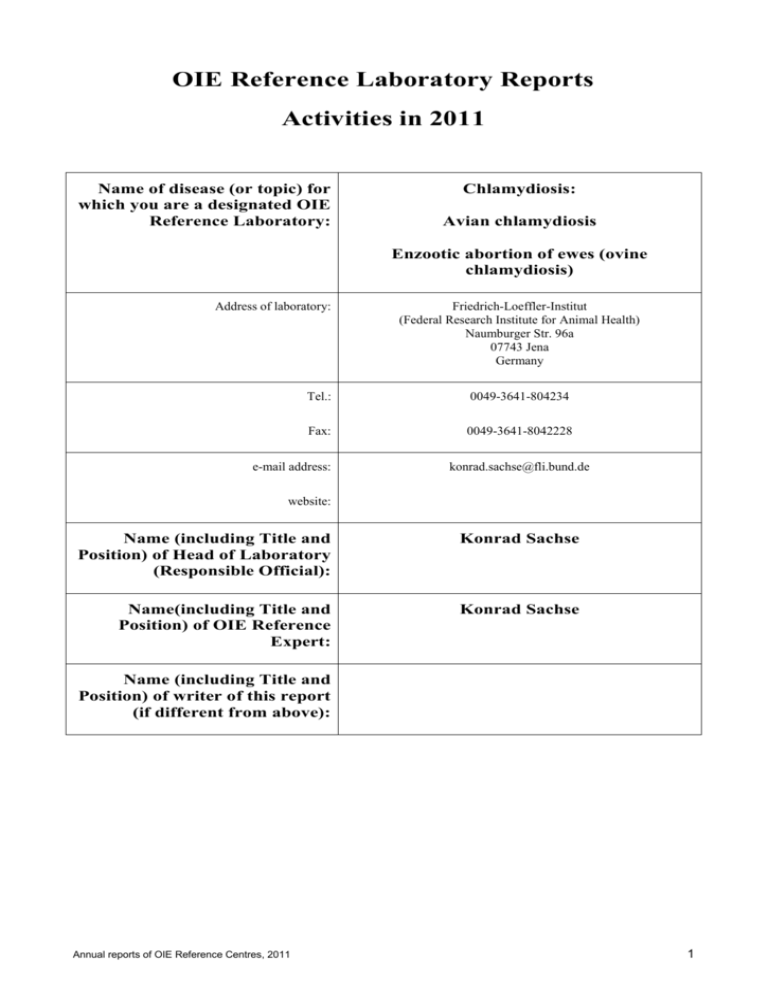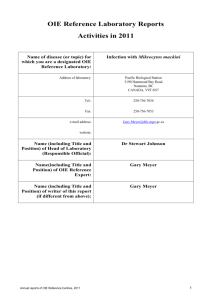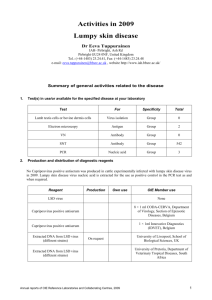Real-time PCR
advertisement

OIE Reference Laboratory Reports Activities in 2011 Name of disease (or topic) for which you are a designated OIE Reference Laboratory: Chlamydiosis: Avian chlamydiosis Enzootic abortion of ewes (ovine chlamydiosis) Address of laboratory: Friedrich-Loeffler-Institut (Federal Research Institute for Animal Health) Naumburger Str. 96a 07743 Jena Germany Tel.: 0049-3641-804234 Fax: 0049-3641-8042228 e-mail address: konrad.sachse@fli.bund.de website: Name (including Title and Position) of Head of Laboratory (Responsible Official): Konrad Sachse Name(including Title and Position) of OIE Reference Expert: Konrad Sachse Name (including Title and Position) of writer of this report (if different from above): Annual reports of OIE Reference Centres, 2011 1 Chlamydiosis Part I: Summary of general activities related to the disease 1. 2. Test(s) in use/or available for the specified disease/topic at your laboratory Test For Specificity Total Real-time PCR DNA Family Chlamydiaceae 2000 Real-time PCR DNA Chlamydia psittaci 124 Real-time PCR DNA Chlamydia abortus 10 DNA microarray (ArrayTube® test) DNA Parallel test for all 9 chlamydial species 200 DNA microarray (ArrayTube® test) DNA Genotyping of Chlamydia psittaci strains 30 ELISA (CHEKIT Chlamydia, Idexx) Antibody Family Chlamydiaceae 514 Cell culture Antigen Species 30 Production and distribution of diagnostic reagents Reagent Quantity provided to national institutions Quantity provided to institutions from OIE Member Countries Chromosomal DNA from reference and field strains (aliquots of ca. 5 µg) 10 47 Cell culture aliquots of chlamydial reference and field strains 13 2 Part II: Activities specifically related to the mandate of OIE Reference Laboratories 3. International harmonisation and standardisation of methods for diagnostic testing or the production and testing of vaccines a) Establishment and maintenance of a network with other OIE Reference Laboratories designated for the same pathogen or disease and organisation of regular inter-laboratory proficiency testing to ensure comparability of results There is frequent exchange of information and expertise with the other Reference Laboratory for Ovine Chlamydiosis, i.e. at the University of Zurich, Switzerland. For instance, 14 samples that gave ambiguous test results in Zurich were re-examined in our lab. Both laboratories are undertaking a joint effort to promote DNA microarray testing as a powerful alternative for diagnosis of chlamydia infections. b) Organisation of inter-laboratory proficiency testing with laboratories other than OIE Reference Laboratories for the same pathogens and diseases to ensure equivalence of results No inter-laboratory testing has been organised in 2011. 2 Annual reports of OIE Reference Centres, 2011 Chlamydiosis International co-operation: Test protocols of real-time PCR assays and DNA microarray tests have been provided to laboratories in Argentina, Croatia, Hong Kong, Italy, the Netherlands, Switzerland, and Ukraine. In some cases, more detailed technical comments explaining the critical points of the technology were provided by e-mail. Partners from Croatia sent a series of samples for re-examination in order to ensure their accreditation status. RL Chlamydiosis was involved in the discussion about the safety of a commercial vaccine for ovine enzootic abortion that came up in 2010 and 2011. Following the publication by Wheelhouse et al (Vaccine, 2010, 28:5657–5663), which provided evidence of the vaccine strain Chlamydia abortus 1B being a possible cause of abortion cases, there was an immediate exchange of information among the leading research groups from France, the United Kingdom and the OIE Reference Laboratory about the implications of those findings. The parties completely agreed that, while suggesting increased awareness and consciousness, the findings in no way changed the cost-benefit assessment of vaccination against this disease. Nevertheless, the study stressed the necessity of using the recently developed diagnostic assay (Laroucau et al., Vaccine, 2010, 28:56535656) to distinguish between vaccine and field strains. RL Chlamydiosis proposes the introduction of an alternative diagnostic reference test for chlamydial infections to replace cell culture. This procedure includes a validated real-time PCR detection assay in conjunction with the ArrayTube® or ArrayStrip® microarray tests. The proposal was published in Veterinary Microbiology (2009, 135, 2-21) and is currently being discussed among the chlamydia research community. 4. Preparation and supply of international reference standards for diagnostic tests or vaccines There are no international reference standards for laboratory diagnosis of chlamydiosis at this point in time. 5. Research and development of new procedures for diagnosis and control The emphasis has been on optimisation of existing assays in 2011. No new tests have been introduced. 6. Collection, analysis and dissemination of epizootiological data relevant to international disease control None 7. Maintenance of a system of quality assurance, biosafety and biosecurity relevant to the pathogen and the disease concerned RL Chlamydiosis is integrated into the Friedrich Loeffler Institute's quality management system. Adherence to the FLI's Quality Management Manual is monitored by regular audits at least once per year. In 2011, the institute passed the re-accreditation inspection, which is conducted every five years. 8. Provision of consultant expertise to OIE or to OIE Member Countries In 2011, the head of RL Chlamydiosis wrote an updated version of the OIE Manual's chapter 2.3.1. Avian Chlamydiosis and reviewed chapter 2.7.7. Enzootic Abortion of Ewes. A fact sheet on enzootic abortion of ewes was also contributed in the European DISCONTOOLS project. 9. Provision of scientific and technical training to personnel from other OIE Member Countries In 2011, researchers and lab diagnosticians from Ukraine, Switzerland and Peru visited the reference lab for technical training and consultations on chlamydial diagnostic methods, with emphasis on molecular detection methods. Annual reports of OIE Reference Centres, 2011 3 Chlamydiosis 10. Provision of diagnostic testing facilities to other OIE Member Countries The reference lab has not been approached for such services. 11. Organisation of international scientific meetings on behalf of OIE or other international bodies None 12. Participation in international scientific collaborative studies No collaborative studies fulfilling this criterion. 13. Publication and dissemination of information relevant to the work of OIE (including list of scientific publications, internet publishing activities, presentations at international conferences) Presentations at international conferences and meetings SACHSE, K. Traditional and innovative diagnostic methods. National Meeting on Chlamydioses and Q fever, Istituto Zooprofilattico Sperimentale dellle Venezie, Legnaro, Italy, 13-14 April 2011 SACHSE, K. Neues aus dem NRL Psittakose. 5. Arbeitstagung des NRL Psittakose, Jena, Germany 19-20 May.2011 SACHSE, K Clamidiosis Aviar en Europa - Epidemiología, diagnóstico y nuevas perspectivas. Primer Congreso Internacional de Zoonosis y Enfermedades Emergentes (VII Congreso Argentino de Zoonosis), Buenos Aires, Argentina, 8-10 June 2011 Scientific publications in peer-reviewed journals BORTH, N., LITSCHE, K., FRANKE, C., SACHSE, K., SALUZ, H.P. HÄNEL, F. (2011) Functional interaction between Type III-secreted protein IncA of Chlamydophila psittaci and human G3BP1. PLoS one 6(1): e16692. CHRISTERSON L, RUETTGER A, GRAVNINGEN K, EHRICHT R, SACHSE K, HERRMANN B. (2011) High-resolution genotyping of Chlamydia trachomatis using a novel multilocus typing (MLT) DNA microarray. J Clin Microbiol. 49, 2838-2843 COLLINGRO A, TISCHLER P, WEINMAIER T, PENZ T, HEINZ E, BRUNHAM RC, READ TD, BAVOIL PM, SACHSE K, KAHANE S, FRIEDMAN MG, RATTEI T, MYERS GS, HORN M. (2011) Unity in Variety the Pan-Genome of the Chlamydiae. Mol Biol Evol. 28, 3253-3270, LENZKO, H., MOOG, U., HENNING, K., LEDERBACH, R., DILLER, R., MENGE, C., SACHSE, K., SPRAGUE, L.D. (2011) High frequency of chlamydial co-infections in clinically healthy sheep flocks. BMC Vet. Res. 7:29 PSARRAKOS P, PAPADOGEORGAKIS E, SACHSE K, VRETOU E. (2011) Chlamydia trachomatis ompA genotypes in male patients with urethritis in Greece - Conservation of the serovar distribution and evidence for mixed infections with Chlamydophila abortus. Mol Cell Probes.25, 168-173. REINHOLD, P., LIEBLER-TENORIO, E., SATTLER, S., SACHSE, K. (2011) Recurrence of Chlamydia suis infection in pigs after short-term antimicrobial treatment. Vet. J. 187, 405–407 REINHOLD, P., SACHSE, K., KALTENBOECK, B. (2010) Chlamydiaceae in cattle: Commensals, trigger organisms, or pathogens? (Review) Vet. J. 189, 257-267 RUETTGER, A., FEIGE, J., SLICKERS, P., SCHUBERT, E., MORRÉ, S.A., PANNEKOEK, Y., HERRMANN, B., DE VRIES, H.J.C., EHRICHT, R., SACHSE, K. (2011) Genotyping of Chlamydia trachomatis strains from culture and clinical samples using an ompA-based DNA microarray assay. Mol. Cell. Probes 25, 19-27 4 Annual reports of OIE Reference Centres, 2011 Chlamydiosis SAIT M, CLARK EM, WHEELHOUSE N, SPALDING L, LIVINGSTONE M, SACHSE K, MARKEY BK, MAGNINO S, SIARKOU VI, VRETOU E, CARO MR, YAGA R, LAINSON FA, SMITH DG, WRIGHT F, LONGBOTTOM D. (2011) Genetic variability of Chlamydophila abortus strains assessed by PCR-RFLP analysis of polymorphic membrane protein-encoding genes. Vet Microbiol. 151, 284-290 SCHÖFL G, VOIGT A, LITSCHE K, SACHSE K, SALUZ HP. Complete genome sequences of four mammalian isolates of Chlamydophila psittaci. J Bacteriol.193, 4258 VOIGT, A., SCHÖFL, G., HEIDRICH, A., SACHSE, K., SALUZ, H.P. (2011) Full-length de novo sequence of the Chlamydophila psittaci type strain, 6BC. J Bacteriol. 193,:2662-2663. Other communications Book chapters: WANG, C., KALTENBOECK, B., SACHSE, K. (2011) Chapter 46: Chlamydophila. In: Molecular Detection of Human Bacterial Pathogens (Ed. Dongyou Liu), CRC Press Taylor & Francis, London, pp. 523-535 SACHSE, K., GALLO VAULET, M.L. (2011) Aplicación de las técnicas moleculares al diagnóstico de las infecciones por clamidias. In: Temas de Zoonosis V (Eds. J. Basualdo, R. Cacchione, R. Durlach, P. Martino, A. Seijo), Asociación Argentina de Zoonosis, Buenos Aires, p.473-478 _______________ Annual reports of OIE Reference Centres, 2011 5


